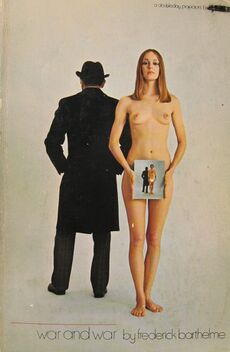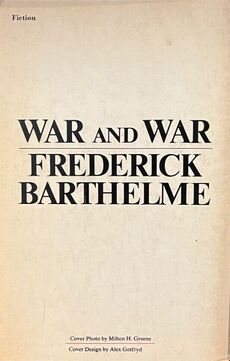War and War


War and War is a a book by Frederick Barthelme that was published in 1971 by DoubleDay.
Background
- Preceded by Rangoon
Cover art
- Milton H. Greene - cover photo
- Alex Gotfryd - cover design
Contents
- 190 pages, 18 chapters
| Chapter | pg. | |
|---|---|---|
| 1. | Introduction. Discussion of sectional character. Auxiliary and deluxe information. Discussion of the inclusion of humanist thrusts. | 9-18 |
| 2. | Discussion of the apparent confusion. Apparent fact and apparent fiction. Things revealed. | 19-28 |
| 3. | Sex, incl. diagrams. | 29-44 |
| 4. | Science in general. Scientific persons, science fiction, stylessness, tribalism, and science as it appears to me. Introduction of characters. Discussion. The life of a character (see 13. for a synopsis of other lives). | 45-54 |
| 5. | Topics and subjects appropriately theoretical, touching the potential for interest. The Idle Chronology. | 55-64 |
| 6. | Local methods. Discussion of local methods, means. | 65-70 |
| 7. | Lazlo becomes scientific overnight. The fictional impulse in the mundane sphere. | 71-80 |
| 8. | The first book as seen from the second. Extra immediate information, supplementary sources. Autobiographical life. Some excerpts. | 81-86 |
| 9. | Trending. Discussion of personal phenomena. The career in the modern world. The drinker's nose. | 87-92 |
| 10. | Photographs and notations. | 93-112 |
| 11. | P.I. Limited interests. Simple curves in single directions. Meaningful quotations. | 113-120 |
| 12. | Synopsis of other lives. Bulky interaction. Geographical locations and the notion of "place." Letters. | 121-142 |
| 13. | Discussion of the sections taken individually. Meanings distilled. | 143-154 |
| 14. | Details. Facts about some real persons. Architectural advice. | 155-160 |
| 15. | Mars, the red planet. Abiogenesis. The present moment. | 161-170 |
| 16. | Solipsism and aphasia. The wrap-up. Dead bodies, pseudomorphs and public works. | 171-180 |
| 17. | Bonus number I. | 181-184 |
| 18. | Respects, goodbyes and goodnights. | 185-190 |
Reviews
New York Times Book Review
August 19, 1971[1]
Donald Newlove
Dear Frederick Barthelme: stop reading. I wish I'd taken your warning on p. 11: “The bulk role of this second book in my life, as it is in yours, is to occupy the time... all I have to do is sit here and blow it out and then they'll buy it and then I'll do another one and so on until I die.” I thought your best line was on p. 12: “Many things have happened here which, to the untrained eye, might appear interesting.” This, Frederick Barthelme is going to be a bad review.
Metaphysically “War and War” is about the passing of time taken in filling up 190 pages. With a good will I read this book in one sitting—at 6:45 A.M., on the sixth day of a total fast my mind clear and hungry inspired by the book I finished last night John Bunyan's “Grace Abounding” which I mention because Frederick Barthelme is an author who tells how he writes every page. And what he's reading: Sartre Chomsky MerleauPonty, et al.
He begins with a goal to stir my lack of interest a schedule of the novel's coming nonevents. He wants no story tensions to pull me from his word play and brainguistics. He will not expose himself to wounds (or ridicule) by showing his feelings. He summons up his essence somewhere between body and typewriter as pages print out — there is no story and I refuse to suggest one.
The author describes this novel as extraconceptual and pataphysical — in short, a puton. It is not pataphysical enough, and I think the spirit of Ubu is missing.
Rigorously strangled pages in the service of “structural linguistics information theory and phenomenology,” all frozen and published in the ninth circle. What is the point of fiction that doesn't stir you—even once—to read on? I forgive Frederick Barthelme for taking up my time since I'm being paid. It is more difficult to forgive myself for the waste of spirit spent reading this book.
Houston Chronicle
February 13, 1972[2]
Ann Waldron
[...] Barthelme worked hard, and waded through a first novel, "Hof." "It's never been published," he said, "and I've robbed it for other books."
His brother, Donald Barthelme Jr., author of "Snow White" and "City Life," helped him find an agent. It had taken Frederick only three or four months to write "Hof," and although it didn't sell, several publishers asked "what Mr. Barthelme is writing now?" So Frederick obligingly sat down and wrote "War and War" in one month.
Doubleday bought "War and War" in 1968. It wasn't published until June, 1971, because the editor who bought it left, the second editor didn't get along with Frederick and the third editor didn't do anything. Finally the fourth editor was found.
Meanwhile, Barthelme put together another novel, "Rangoon," which he says is a "combination of stuff," presumably some of the bits and pieces of "Hof," and a new publisher, Winter House, brought it out in 1970. "Rangoon" is illustrated by Mayo Thompson, an old friend of Frederick's Red Krayola days.
"'War and War' is the leading edge of my development," Barthelme said with a straight face. "It's more serious."
Neither book got much critical attention. "War and War" was panned on Page 46 of the New York Times Book Review. [...]
Pretty Goes with Pretty
October 15, 2007[3]
[...] Barthelme departed from the Red Crayola after their second or third album, finding his own success as a writer and teacher instead. Since his second novel, Second Marriage, published in 1984, Barthelme’s fiction has been of a more realist bent—everyday people, usually living in the south. But his first book, War and War, was published in 1971 and was written between 1966–69, when he was still a member of the Red Crayola. The book is experimental (and out of print), unlike his more well-known work. If it is spoken of at all, it is usually noted for being similar (and inferior) to brother Donald’s metatextual, language-obsessed style.
It’s one of my favorite books on my shelves—not for its content but for its dated yet wonderful cover. Don’t ask me to explain it; I just like it. The book itself is a stream-of-consciousness pastiche of fiction and (drug-addled? art-school pretentious? merely youthful?) fact. It’s less a novel than a description of the novel Barthelme is writing. It’s a combination of lists, diagrams, photographs, and a constant self-awareness of truth and lies and revision, both of truth and of lies.
It's not a particularly great book, but Crayola fans may want to search it out, both because it's a document from the band's earliest days and because Mayo Thompson appears throughout the novel. [...]